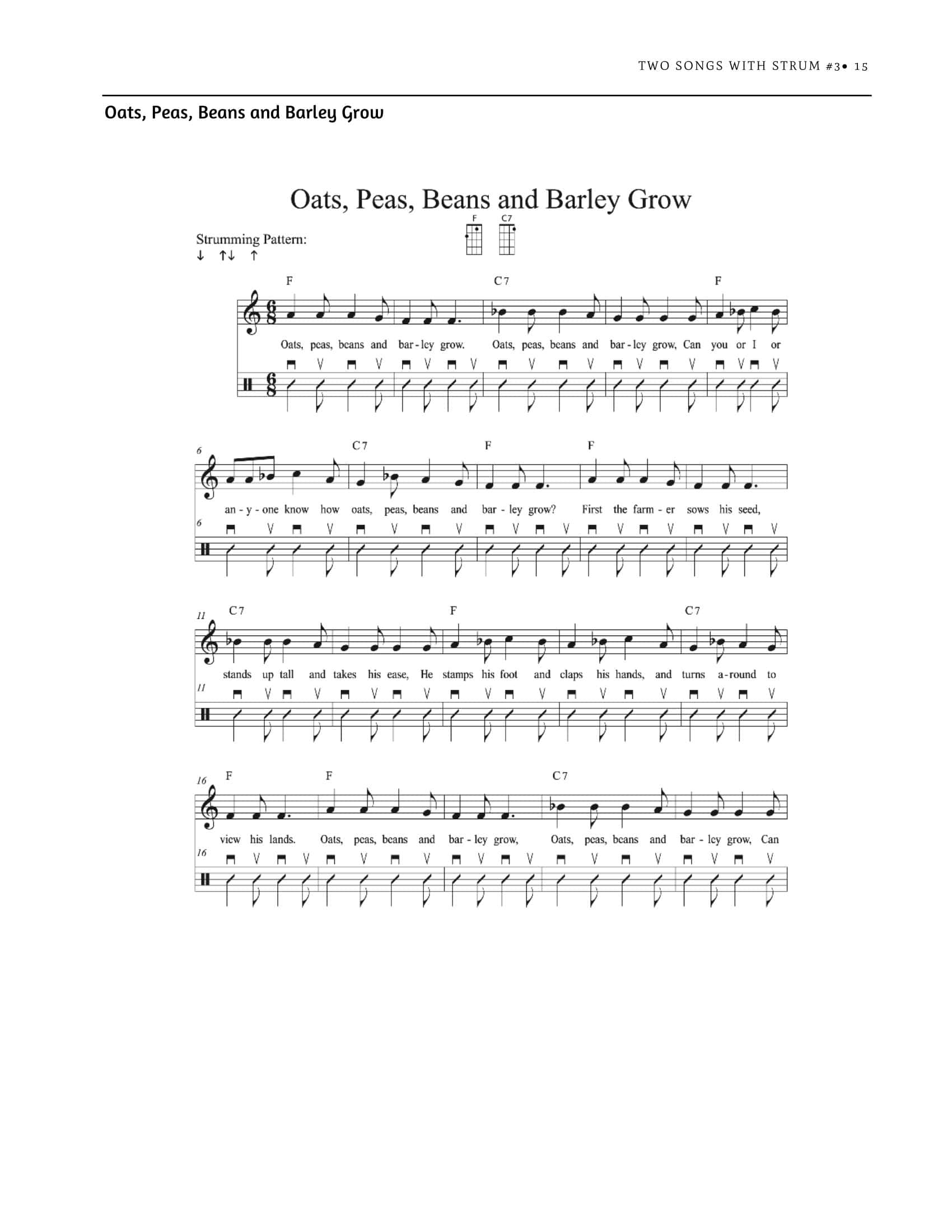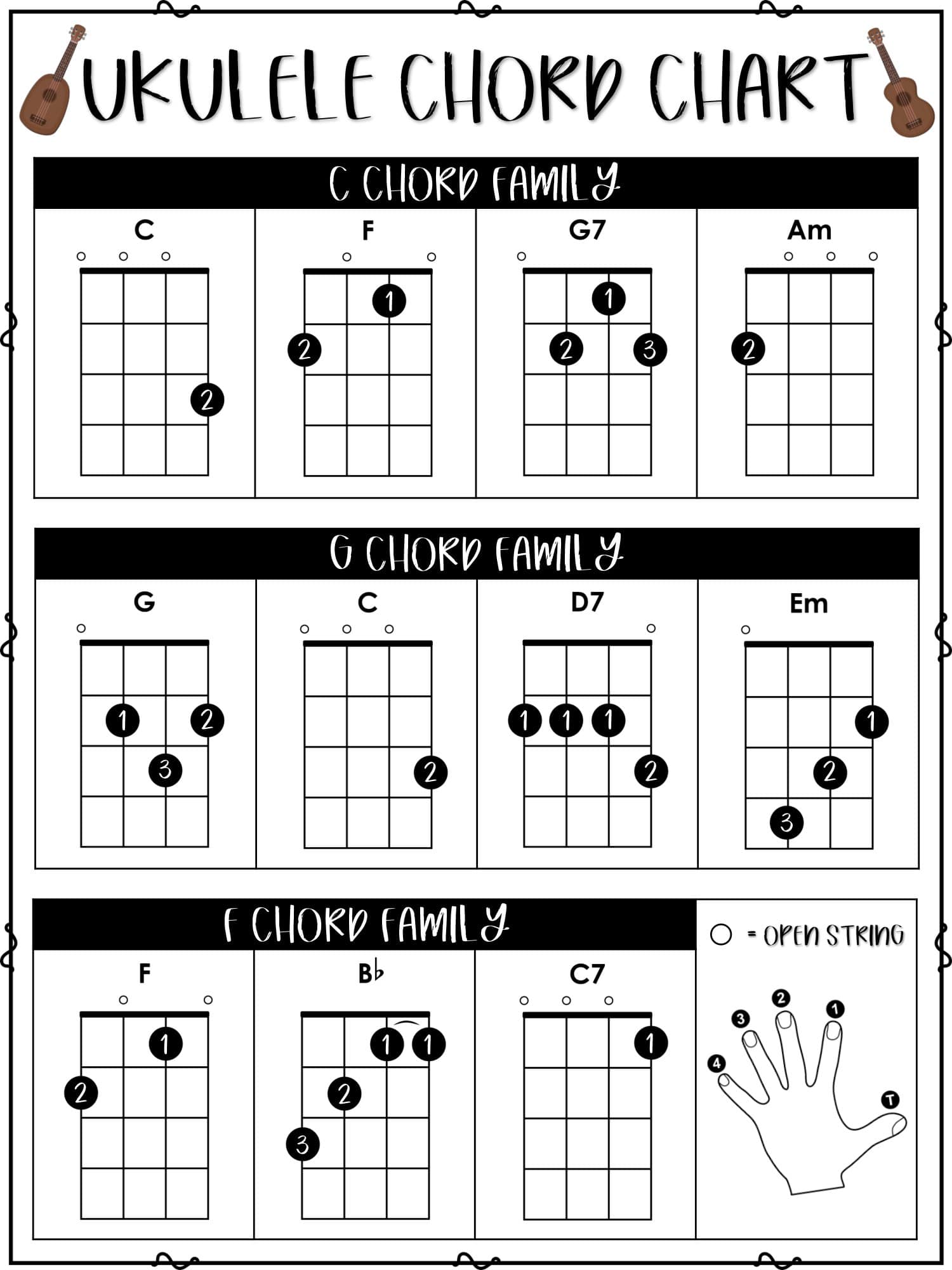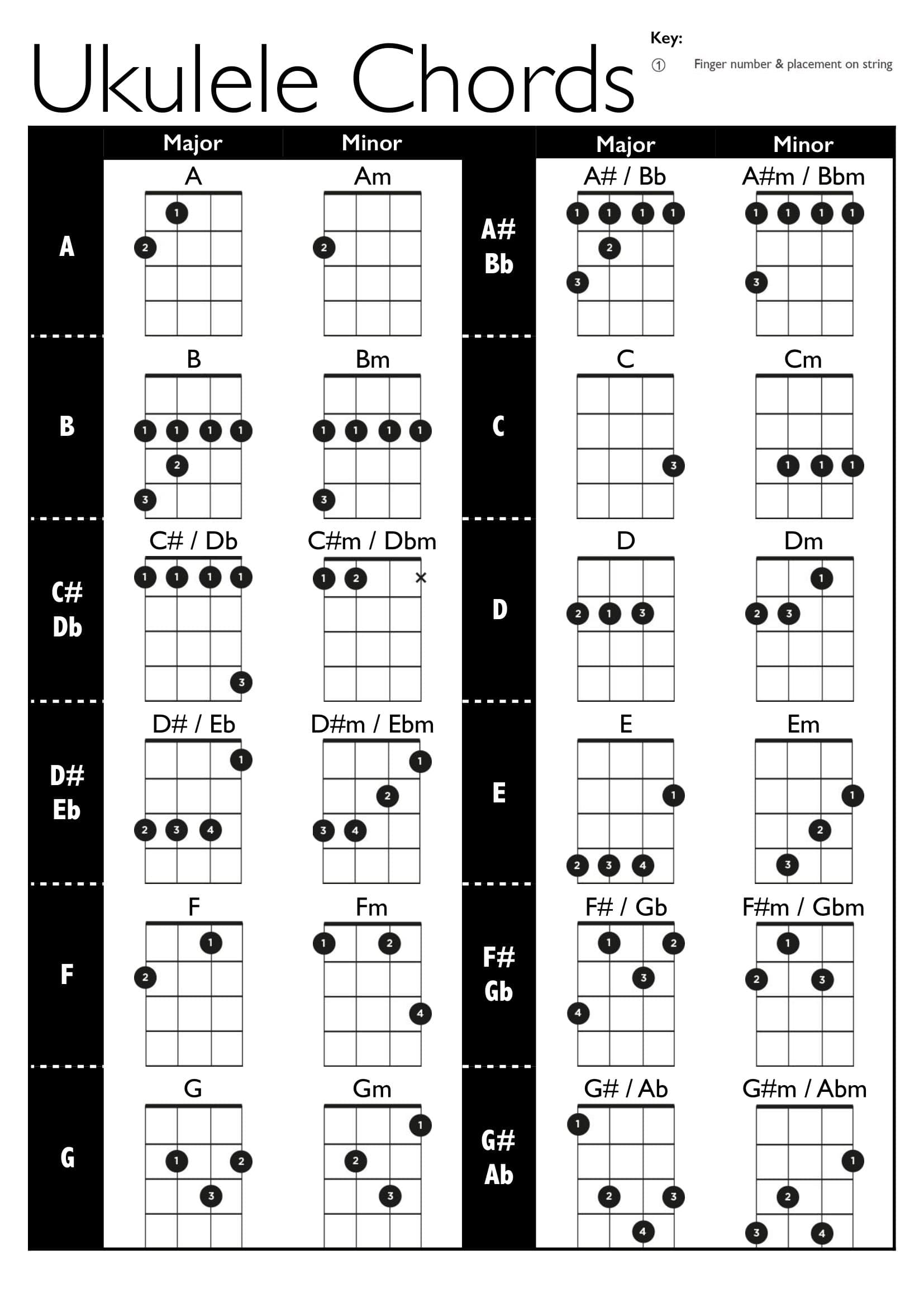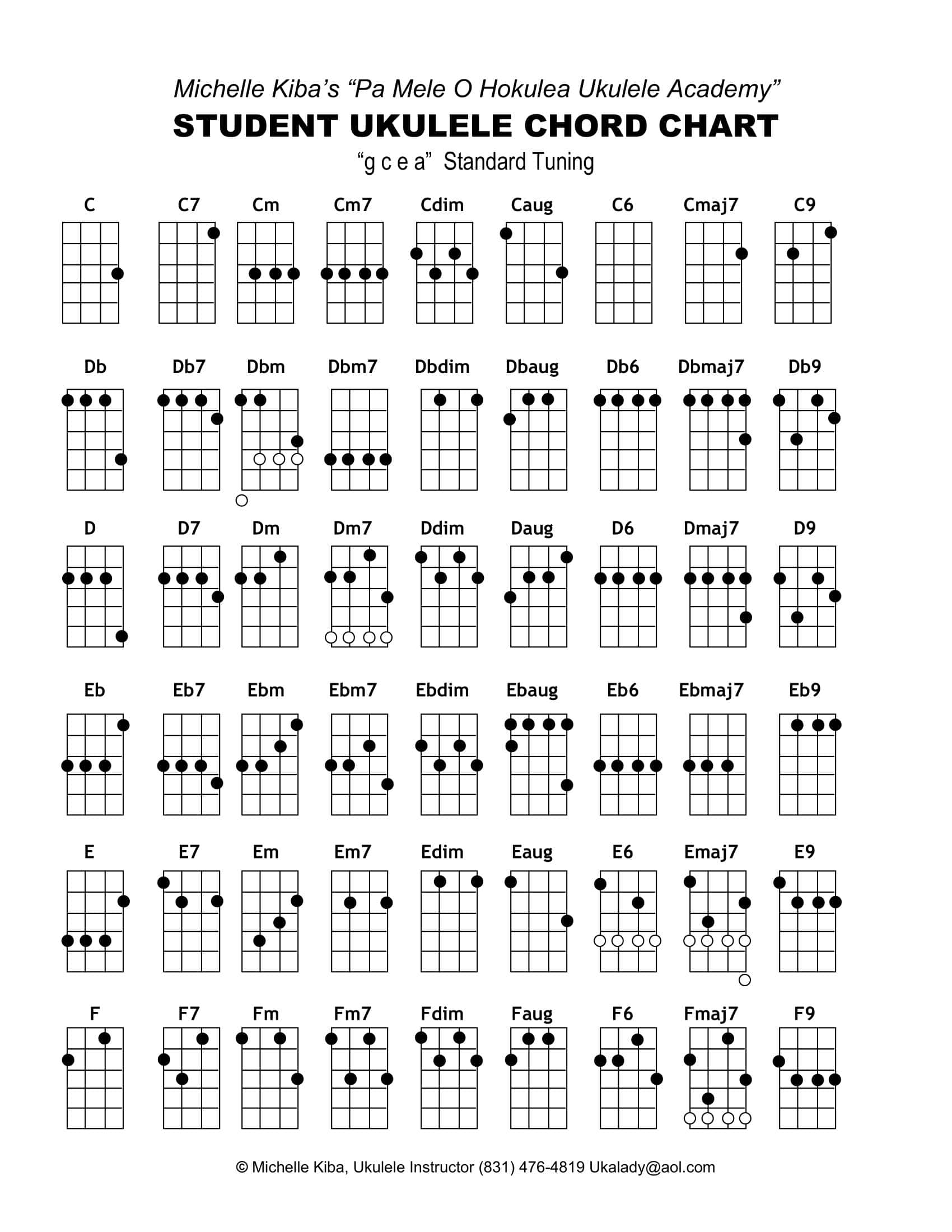The ukulele is a fun and approachable instrument that anyone can learn to play. However, memorizing new chords is one of the first hurdles beginning ukulele players face. This is where chord charts come in handy! A ukulele chord chart shows common chords visually, allowing players to quickly reference chord shapes and finger positions.
Having a printable chord chart makes practicing and learning new songs easier, faster, and more enjoyable. In this article, we’ll highlight key chords to know and how to use a chord chart effectively when learning ukulele. We’ll also provide a free, downloadable PDF ukulele chord chart that players can print and use to master their first chords. With the right chord chart, new ukulele players can progress faster and have more fun strumming away.
Table of Contents
What is a Ukulele Chord Chart?

A ukulele chord chart is a visual reference that shows common ukulele chords and how to play them. The charts display chord name, chord diagram, and fretboard finger positions for major, minor, and seventh chords. Chord charts allow new ukulele players to quickly look up unfamiliar chords by their name and see the correct finger placement to make the chord shape.
Having an accurate, easy-to-read chord chart is essential for learning new songs and progressing on the ukulele. Ukulele chord charts come in handy printed or digital formats for convenient use during practice and performances. With the right chord chart, ukulele players can expand their repertoire and sharpen their skills.
Ukulele Chord Chart Printable
The ukulele is a fun and approachable instrument that has seen a major resurgence. A printable ukulele chord chart is an essential tool when learning to play this petite 4-stringed guitar.
Charts illustrate proper finger placement for the most common chords. Rather than memorizing hand positions, you can reference the chart as you practice chord changes. Simple one page charts provide beginner chords like C, F, G7 and Am. More extensive charts add barre chords, 7th chords and additional chord voicings.
Ukulele chord charts also depict strumming patterns for practicing rhythm techniques. Down and up strum markings are shown above chord boxes. Charts with numbered frets clarify how to play chord progressions up the neck. Printable ukulele resources make the instrument more accessible to new players. They facilitate practicing proper technique without formal instruction.
Major Chords of Ukulele
Major chords form the backbone of Western music, conveying a sound that is often described as bright, happy, and resolute. Whether we’re discussing classical music, pop, rock, or folk, major chords play a fundamental role in shaping melodies and harmonies.
When we transition to the ukulele, a compact string instrument renowned for its warm, tropical tone, these major chords acquire a unique resonance and tonality. With its four strings, the ukulele offers a simplicity and accessibility that makes it a favored instrument for beginners. However, don’t let this simplicity deceive you. The ukulele has its own challenges, and mastering the major chords is the first step to unlocking its melodic potential.
Common Major Chords: C, G, F, A, D, E
- C Major: This chord is probably the easiest to play on the ukulele. Place your ring finger on the third fret of the bottom string (A-string), and let the other strings ring open. This gives you a clear, bright C major sound.
- G Major: G major requires you to use three fingers. Place your index finger on the second fret of the C-string, your ring finger on the third fret of the E-string, and your middle finger on the second fret of the A-string. The top string (G-string) will remain open.
- F Major: For the F chord, place your middle finger on the second fret of the G-string and your index finger on the first fret of the E-string. The C and A strings are played open.
- A Major: The A major chord involves placing your middle finger on the second fret of the G-string and your index finger on the first fret of the C-string. The E and A strings are left open.
- D Major: To form a D major chord, you’ll use three fingers. Place your index, middle, and ring fingers on the second fret of the G, C, and E strings respectively. The A-string is played open.
- E Major: E major is a bit more challenging. Place your index finger on the first fret of the G-string, your middle finger on the second fret of the C-string, your ring finger on the fourth fret of the E-string, and your pinky on the fourth fret of the A-string.
Playing Tips and Techniques
Playing ukulele chords can be an absolute joy, but to sound fluid and precise, consider the following tips:
- Hand Positioning: Ensure your wrist is relatively straight, avoiding any unnecessary bending. This positioning will help with finger reach and reduce any strain.
- Finger Pressure: Apply sufficient pressure to the strings to get a clear sound, but not so much that you strain your fingers or bend the strings out of tune.
- Transitioning Between Chords: Start slow. Practice transitioning between two chords until you can do it smoothly without looking. Muscle memory is key here. With time, your fingers will automatically move to the right positions.
- Thumb Placement: Your thumb should rest at the back of the ukulele’s neck, offering support and balance. It should not be overly rigid; a relaxed grip will facilitate smoother chord transitions.
- Strumming: When strumming, use the pad or nails of your thumb, or the nails of your index finger, depending on your comfort. Ensure your wrist remains loose for a free and flowing strumming motion.
- Practice: As with any instrument, regular practice is key. Set aside dedicated time each day to practice, focusing on chord transitions and ensuring each note rings clear.
- Listen and Adjust: Pay attention to the sound you produce. If a note sounds muted or buzzy, adjust your finger positioning or pressure accordingly.
Minor Chords of Ukulele
Minor chords, in contrast to their major counterparts, carry a certain depth and melancholy that resonate profoundly with the human experience. These chords often evoke feelings of sadness, introspection, or even mystery. In Western music, they add layers of emotional complexity to compositions, making them indispensable.
On the ukulele, a traditionally upbeat and bright sounding instrument, minor chords introduce an intriguing dimension. They allow the ukulele player to tap into a more somber and introspective soundscape, highlighting the versatility of this seemingly simple instrument.
Common Minor Chords: Am, Em, Dm, Cm, Bm, Fm
- Am (A minor): Among the simplest to play on the ukulele. Just place your middle finger on the second fret of the G-string, while the rest of the strings are played open, resulting in a rich, mellow sound.
- Em (E minor): For Em, place your index finger on the second fret of the A-string, your middle finger on the third fret of the E-string, and your ring finger on the fourth fret of the C-string. The G-string remains open.
- Dm (D minor): For this chord, place your index finger on the first fret of the E-string, your middle finger on the second fret of the G-string, and your ring finger on the second fret of the C-string. The A-string is left open.
- Cm (C minor): A slightly more challenging chord, place your ring finger across the third fret of the bottom three strings (C, E, and A strings), while leaving the top G-string open.
- Bm (B minor): Barre your index finger across the second fret of all four strings and then place your ring finger on the fourth fret of the G-string. This is a full barre chord and might require a bit more strength and practice.
- Fm (F minor): For Fm, press your index finger on the first fret of the G-string, your ring finger on the third fret of the A-string, and your middle finger on the first fret of the E-string. The C-string remains open.
Transition Tips Between Major and Minor Chords
When it comes to transitioning between major and minor chords, it’s essential to understand their similarities and differences. Both share root notes but have varied finger positions which give them their distinct sound. Here are some tips to ease these transitions:
- Anchor Points: When moving between chords, try to identify ‘anchor’ fingers or points. These are fingers that either remain on the same string or move to an adjacent string. By minimizing unnecessary movement, transitions become smoother.
- Practice Switching Pairs: Instead of trying to master all transitions at once, start with pairs of chords. For instance, practice transitioning between C and Am, or G and Em. This targeted approach can be more effective than trying to juggle too many transitions simultaneously.
- Hand Positioning: Keep your wrist flexible and fingers relaxed. Avoid locking your wrist or fingers in rigid positions, which can slow down transitions and lead to hand fatigue.
- Thumb Placement: Ensure your thumb remains at the back of the ukulele neck, providing stability. A consistent thumb position will assist in smoother chord transitions.
- Visualization: Before you even move your fingers, visualize the next chord shape. Familiarize yourself with how each chord looks and feels.
- Regular Practice: Consistency is key. Regular, focused practice will help build muscle memory, making transitions more intuitive over time.
- Play Along with Music: One of the most enjoyable ways to practice is by playing along with your favorite songs. This not only helps with transitions but also with rhythm and timing.
Seventh Chords of Ukulele
Seventh chords, as the name implies, are essentially major or minor chords that have been embellished with a seventh note. They infuse a rich, jazzy flavor into songs, adding depth, tension, and complexity. While three-note (triad) chords provide a solid foundation in music, the introduction of a fourth note (the seventh) brings in a unique color that can make a song sound more sophisticated or bluesy. On the ukulele, with its limited number of strings, playing seventh chords showcases the instrument’s capacity to produce intricate and lush harmonies.
Common Seventh Chords: C7, G7, F7, A7, E7, D7
- C7: Perhaps one of the simplest seventh chords to play on the ukulele, C7 requires placing your index finger on the first fret of the A-string. All other strings are played open.
- G7: To form a G7 chord, place your index finger on the first fret of the E-string, your middle finger on the second fret of the C-string, and your ring finger on the second fret of the A-string. The G-string remains open.
- F7: For F7, start with the regular F chord: your middle finger on the second fret of the G-string and your index finger on the first fret of the E-string. Then, add your ring finger to the third fret of the C-string. The A-string is played open.
- A7: The A7 chord is straightforward. Simply place your index finger on the first fret of the C-string, leaving the other strings open.
- E7: E7 is a beautiful sounding chord on the ukulele. Place your index finger on the first fret of the G-string, your middle finger on the second fret of the C-string, and your ring finger on the second fret of the A-string. The E-string is left open.
- D7: For D7, place your index finger on the second fret of the G-string, and your middle finger on the second fret of the E-string. The C and A strings remain open.
Using Seventh Chords in Progressions
Seventh chords can be seen as bridges or connectors in a chord progression, lending a touch of tension before a resolution. Here’s how you can effectively incorporate them:
- Blues and Jazz Flavors: Seventh chords are staples in blues and jazz. Introducing them in standard progressions can give your music a jazzy or bluesy edge. For instance, transitioning from G to G7 before resolving to C can add a touch of sophistication to your progression.
- Building Tension: The essence of the seventh chord lies in its inherent tension. It’s almost like the chord is asking to be resolved. This tension can be harnessed to lead listeners to a satisfying resolution, usually to a major or minor chord.
- Experiment with Sequences: Don’t be afraid to experiment. Try substituting major chords in familiar progressions with their seventh counterparts and listen to the change in mood and tonality.
- Enhance Endings: One of the traditional uses of seventh chords is right before the end of a song or section. It provides a sense of impending closure, making the final resolution more impactful.
- Understand Harmony: Seventh chords work best when they are used in a context that understands the underlying harmony. Knowing the scales and the relationship between chords can help you determine where a seventh chord might be most effective.
Other Essential Chords
Diminished and Augmented Chords
The world of ukulele chords extends far beyond the realms of major, minor, and seventh chords. Among the more unique and intriguing are diminished and augmented chords.
Diminished Chords: Characterized by a tense, unresolved sound, diminished chords are constructed by stacking minor thirds. On the ukulele, they have a mysterious and somewhat eerie tonality. An example is the Gdim chord. To play it, you can place your fingers as follows: index on the first fret of the C-string, middle on the first fret of the E-string, and ring on the second fret of the A-string.
Augmented Chords: These chords sound dreamy and unsettled. An augmented chord is a major chord with a raised fifth. For instance, to play Caug on the ukulele, place your middle finger on the second fret of the G-string, ring finger on the first fret of the C-string, and your pinky on the first fret of the E-string.
Both diminished and augmented chords can be used to add color and tension in your chord progressions, making them particularly valuable for intermediate to advanced players looking to expand their sound palette.
Suspended Chords
Suspended chords, often denoted as sus2 or sus4, offer a sound that’s hovering or “suspended” between major and minor chords, adding an air of anticipation. They are called “suspended” because they suspend the third note of the scale, replacing it with either a second or fourth.
For instance, Dsus4 on a ukulele is played by placing your index finger on the second fret of the G-string, your middle finger on the second fret of the C-string, and your ring finger on the third fret of the E-string. Suspended chords work wonders in creating tension and release within a song, especially when played right before resolving to a major or minor chord.
Additional Extended Chords (9th, 11th, 13th)
Extended chords introduce additional notes beyond the basic triad and seventh, adding layers of complexity and richness. They are commonly used in jazz, R&B, and some more advanced pop compositions.
9th Chords: These are essentially seventh chords with an added ninth. For example, C9 includes the notes C-E-G-Bb-D. On the ukulele, playing such a chord might require omitting one or two notes due to the instrument’s four strings, but the essence of the chord remains.
11th and 13th Chords: These chords further extend the harmony by adding the 11th and 13th notes, respectively. They’re less common on the ukulele given the limitations in terms of strings and frets, but in the right context, even a hint of these chords can add a lot of depth to a progression.
When incorporating extended chords, it’s essential to understand the underlying harmony and context. They can provide a lush, sophisticated sound, but using them judiciously is key. Overusing them might make a progression sound overly complicated or muddy.
Ukulele Chord Variations and Finger Placement
The ukulele, with its compact size and distinct tonal qualities, offers an array of chords and techniques that can be employed to create versatile sounds. However, it’s not just about knowing which chords to play, but how to play them. There’s an art to finger placement and understanding chord variations which can drastically affect a song’s feel and progression.
Alternate Fingerings
Much like other stringed instruments, many ukulele chords can be fingered and played in multiple ways. These alternative fingerings can make transitioning between chords smoother and more efficient. Here’s why they’re beneficial:
- Ease of Transition: Alternate fingerings can simplify the move from one chord to another. For example, while the G chord can be played with fingers 1, 2, and 3, using fingers 2, 3, and 4 might make it easier to transition to certain other chords.
- Variety in Sound: Playing the same chord using different fingerings can produce subtle tonal variations, giving you more options for expression.
- Comfort: Some fingerings may feel more comfortable than others, depending on the player’s hand size and finger flexibility.
Advanced Techniques: Barre Chords, Slides, and Hammer-ons
- Barre Chords: These chords involve pressing down on multiple strings across the fretboard with a single finger, often the index. Barre chords are movable, meaning the shape of the chord remains constant as you move up and down the fretboard. For instance, the Bm chord is a barre chord where the index finger presses all the strings at the second fret while the ring finger presses the fourth fret of the G-string. Once you’ve mastered this shape, you can move it up and down the neck to play different minor chords.
- Slides: Slides add flavor to your playing. They involve pressing down on a string and “sliding” your finger along to another fret without lifting it. This creates a smooth transition between notes. Slides can be used in solo playing or to add ornamentation to chords.
- Hammer-ons: A hammer-on is a technique that produces two musical notes for the action of striking the string once. To perform a hammer-on, pluck a string and then, without plucking again, forcefully press down a finger to sound the next note. For instance, on the A-string, you can play the open string and then quickly press down the second fret to sound the note B. This technique creates a fluid, legato sound between the two notes.
Incorporating these techniques and variations can significantly elevate your ukulele playing. While it might seem daunting at first, especially when integrating advanced techniques, the key lies in persistent practice. Over time, your fingers will develop the muscle memory required, and these techniques will become second nature.
Are Ukulele Easy To Learn?
The ukulele is often touted as one of the easiest musical instruments for beginners to pick up and start playing. There are a few key reasons the ukulele can be considered easier to learn than many other instruments.
Firstly, the ukulele itself is small, lightweight, and comfortable to hold in various positions. The compact size and approachable feel of a uke helps new players feel at ease handling the instrument right away. In contrast, larger instruments like the guitar or cello can be more difficult and awkward early on.
Additionally, the ukulele only has 4 nylon strings and a relatively minimal number of frets. This makes navigating the strings and fretboard simpler compared to instruments with more strings or complex fretboards. There are also less notes and chords to learn on ukulele at first.
Lastly, basic chords and strumming patterns can be learned quickly to start playing songs right away. The ukulele lends itself well to picking up chord fingerings through chord charts. Simple strumming comes naturally. This allows new ukulele players to dive into having fun with real songs almost immediately.
While mastering the ukulele still requires committed practice over time, the basics of holding, playing, and making music on the ukulele can be grasped smoothly by most beginners. The uke’s small size, limited strings and frets, and quick progressions make it one of the more beginner-friendly instruments.
Conclusion
Learning to play chords is essential for any beginning ukulele player. Following a chord chart allows you to quickly reference proper finger positions for major, minor, and seventh chords. In this article, we’ve discussed core chords for the ukulele and effective ways to use a printable chord chart in your practice routine.
With the free ukulele chord charts attached, you now have helpful visual guides to master your chord proficiency. Study the charts to memorize each chord shape and practice transitioning smoothly between them. Have the PDF or Word chart on hand during your practice sessions for an easy way to look up chords. Mastering the chords on the chart will have you strumming songs in no time! Print out your ukulele chord charts today and use them to take your playing skills to the next level.
FAQs
How do I read a ukulele chord chart?
A chord chart usually displays a diagram of the ukulele’s fretboard from the top-down view. Vertical lines represent strings, and horizontal lines represent frets. Dots indicate where you should place your fingers, and sometimes numbers are added to show which fingers to use.
Why do some chords have multiple shapes on chord charts?
Some chords can be played in various positions on the fretboard, resulting in different voicings or sounds. A chord chart might show multiple shapes for these chords to offer players different tonal options or to facilitate smoother transitions between chords.
Are there chord charts specifically for different ukulele sizes (soprano, concert, tenor, baritone)?
Yes! While soprano, concert, and tenor ukuleles typically have the same tuning (G-C-E-A) and can use the same chord charts, baritone ukuleles have a different tuning (D-G-B-E, like the top four strings of a guitar). Thus, baritone ukuleles require their own chord charts.
Why do some chords seem missing from my chord chart?
While a basic chord chart covers many common chords, it might not include every possible chord due to space constraints. More advanced or less common chords might be found in expanded chord charts or specific music theory books.
How do I use a chord chart to improve transitions between chords?
By studying a chord chart, you can identify common finger placements between chords and practice shifting between them. Over time, this will help improve your speed and fluidity when transitioning during a song.
What are inversions in the context of a ukulele chord chart?
Inversions refer to different ways to play a chord by altering the order of its notes. On a ukulele chord chart, inversions will change the finger placement, resulting in a slightly different sound while still retaining the chord’s essential characteristics.
How often should I refer to a chord chart when learning?
Initially, you might refer to a chord chart quite frequently to familiarize yourself with chord shapes. As you gain experience and muscle memory, the need to consult the chart will decrease. However, it remains a valuable resource when encountering unfamiliar chords or when exploring advanced techniques.









































![Free Printable Morse Code Charts [Numbers, Alphabet] 1 Morse Code Chart](https://www.typecalendar.com/wp-content/uploads/2023/09/Morse-Code-Chart-150x150.jpg)

![43+ Free Printable 134A PT Charts [Download PDF] 3 134A PT Chart](https://www.typecalendar.com/wp-content/uploads/2023/09/134A-PT-Chart-150x150.jpg)
